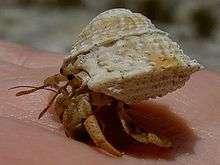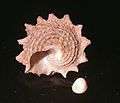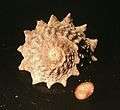Lithopoma phoebium
Lithopoma phoebium, common name the longspine star shell, is a species of medium-sized sea snail, a marine gastropod mollusk in the family Turbinidae, the turban snails.[1]
| Lithopoma phoebium | |
|---|---|
 | |
| Hermit crab in a shell of Lithopoma phoebium | |
| Scientific classification | |
| Kingdom: | Animalia |
| Phylum: | Mollusca |
| Class: | Gastropoda |
| Clade: | Vetigastropoda |
| Order: | Trochida |
| Superfamily: | Trochoidea |
| Family: | Turbinidae |
| Genus: | Lithopoma |
| Species: | L. phoebium |
| Binomial name | |
| Lithopoma phoebium (Roding, 1798) | |
| Synonyms[1] | |
| |
Distribution
This is a tropical Western Atlantic species.
Distribution of Lithopoma phoebium include: Aruba, Belize, Bonaire, Caribbean Sea, Cayman Islands, Colombia, Costa Rica, Cuba, Curaçao, Gulf of Mexico, Jamaica, Lesser Antilles, Mexico, Panama, Puerto Rico, San Andres and Venezuela.[2]
Habitat
The minimum recorded depth for this species is 0 m; maximum recorded depth is 91 m.[3]
 basal view
basal view apertural view
apertural view apical view
apical view
gollark: *Apparently* this is just the script for my Discord bot. Boring.
gollark: I clicked "MEM" in `htop`.
gollark: I'm not joking about the mysterious Python program. I forgot what this actually is.
gollark: This makes it the most RAM-consuming thing on my server, followed by VictoriaMetrics, Factorio, systemd-journald, syncthing, and a mysterious python program.
gollark: Correction: 300MB presently.
References
- Bouchet, P. (2011). Lithopoma phoebium (Röding, 1798). Accessed through: World Register of Marine Species at http://www.marinespecies.org/aphia.php?p=taxdetails&id=413409 on 2012-03-15
- Rosenberg, G. (2010). Astralium phoebium (Röding, 1798). Accessed through: World Register of Marine Species at http://www.marinespecies.org/aphia.php?p=taxdetails&id=419498 on 2011-03-17
- Welch J. J. (2010). "The "Island Rule" and Deep-Sea Gastropods: Re-Examining the Evidence". PLoS ONE 5(1): e8776. doi:10.1371/journal.pone.0008776.
- Turgeon, D.D., et al. 1998. Common and scientific names of aquatic invertebrates of the United States and Canada. American Fisheries Society Special Publication 26 page(s): 59
- Williams, S.T. (2007). Origins and diversification of Indo-West Pacific marine fauna: evolutionary history and biogeography of turban shells (Gastropoda, Turbinidae). Biological Journal of the Linnean Society, 2007, 92, 573–592.
- Rosenberg, G., F. Moretzsohn, and E. F. García. 2009. Gastropoda (Mollusca) of the Gulf of Mexico, Pp. 579–699 in Felder, D.L. and D.K. Camp (eds.), Gulf of Mexico–Origins, Waters, and Biota. Biodiversity. Texas A&M Press, College Station, Texas
- Alf A. & Kreipl K. (2011) The family Turbinidae. Subfamilies Turbininae Rafinesque, 1815 and Prisogasterinae Hickman & McLean, 1990. In: G.T. Poppe & K. Groh (eds), A Conchological Iconography. Hackenheim: Conchbooks. pp. 1–82, pls 104-245.
External links
| Wikimedia Commons has media related to Lithopoma phoebium. |
- "Astralium phoebium". Gastropods.com. Retrieved 15 March 2012.
This article is issued from Wikipedia. The text is licensed under Creative Commons - Attribution - Sharealike. Additional terms may apply for the media files.